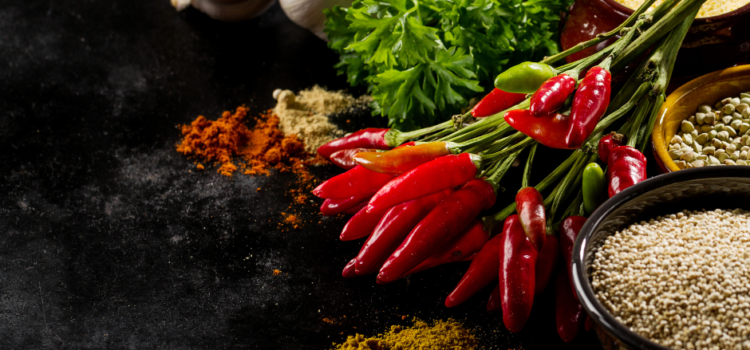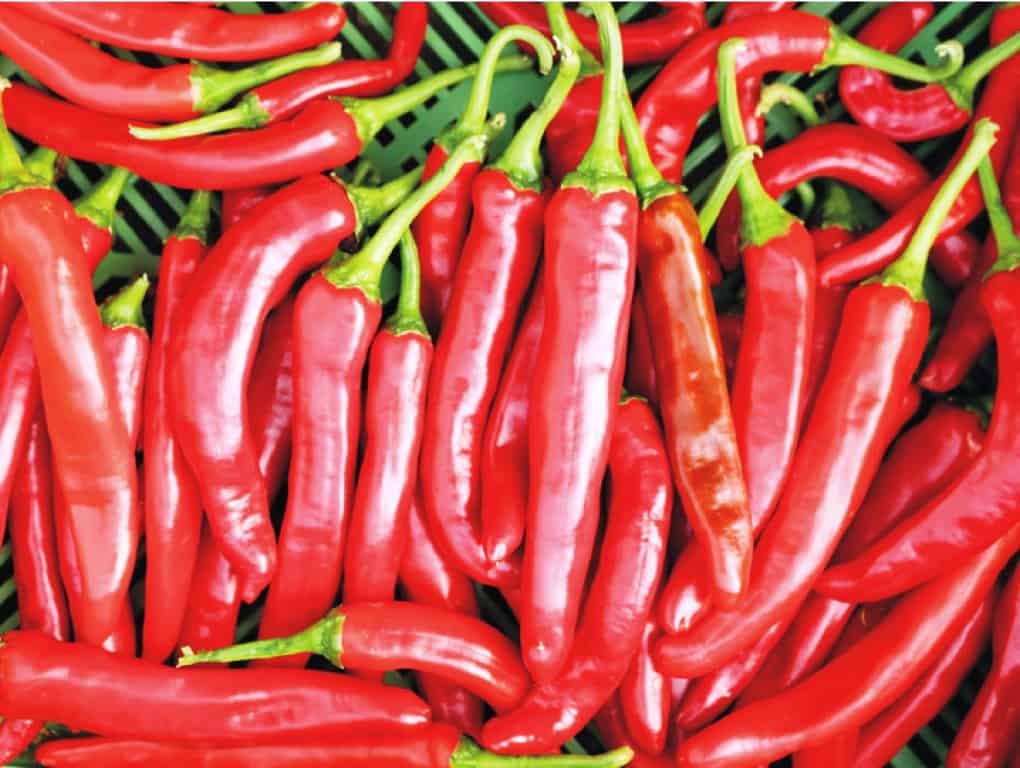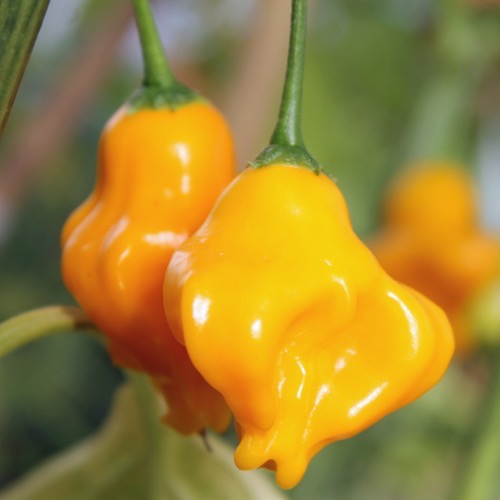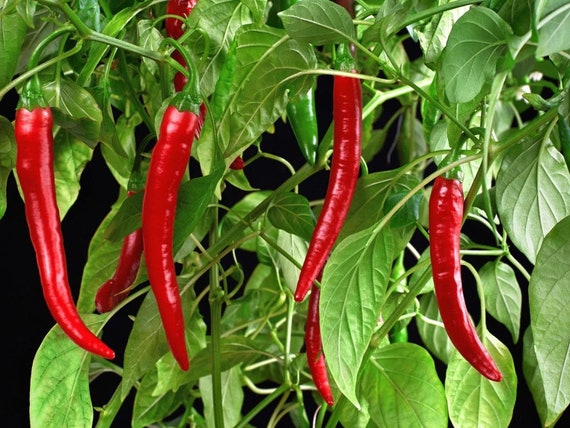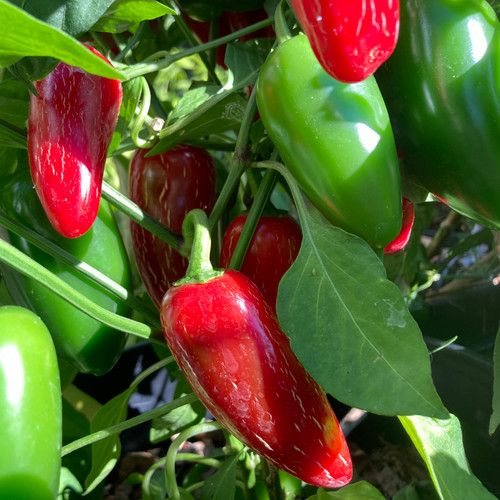Grow Your Own Spicy Delight Find the Best Chili Varieties to Plant in the Costa Blanca and Expert Tips for Success
Costa Blanca, with its 300 days of sun per year, is an ideal location for growing your own chili peppers. Chili peppers are a versatile ingredient used in many dishes and have many health benefits. By growing your own chili peppers, you can have access to fresh produce, save money on groceries, and even create your own unique flavors.
To get started, it is important to choose the right variety of chili pepper for your growing conditions. Some of the best varieties for the Costa Blanca region include the spicy ‘Jalapeno’, the sweet ‘Bell Pepper’, and the fiery ‘Scotch Bonnet’.
When it comes to growing chili peppers, it is possible to do so on your terrace, balcony or garden. To ensure the best results, make sure to plant your chili peppers in a sunny location and provide them with well-draining soil and regular watering. To promote healthy growth, consider using organic fertilizers and providing support for the plants as they grow taller.
By following these tips, you can successfully grow your own chili peppers on the Costa Blanca and enjoy fresh, healthy, and delicious produce all year long.
Lets take a deep dive into some of the best Chile varieties you can grow on the Costa Blanca
Taeyang Chilis Heat Rating-HOT
Taeyang Chilis are a unique and flavorful type of chili pepper that originate from South Korea. They are known for their intense heat and bold, slightly sweet taste. The name “Taeyang” means “big sun” in Korean, which is a reference to the large size of these peppers.
The Taeyang chili is a type of Korean chili that is significantly larger than other chili varieties. They can grow up to 4 inches long and are usually red in color when ripe. The flesh of the pepper is thick and has a slightly sweet taste, with a heat that builds gradually and can last for a long time.
These chili peppers are widely used in Korean cuisine, and they are often used to make a variety of sauces and pastes that are used as condiments or to add flavor to dishes. They are also used to make gochujang, which is a traditional Korean chili paste that is used as a base for many Korean dishes, including stews, soups, and sauces.
In addition to their use in cooking, Taeyang chilis are also prized for their health benefits. They are a rich source of vitamin C and carotene, and they also contain capsaicin, which has been shown to have anti-inflammatory and pain-relieving properties.
Overall, Taeyang chilis are a delicious and versatile ingredient that are essential for anyone looking to add heat and flavor to their cooking. Whether used fresh or dried, these chili peppers are sure to add a bold, spicy kick to any dish.
Taeyang Chili Pepper Plants: Growing and Care Guide
Taeyang chili pepper plants are a unique and flavorful addition to any home garden. With their intense heat and bold, slightly sweet taste, these chili peppers are widely used in Korean cuisine. In order to successfully grow Taeyang chili pepper plants, it is important to understand the specific growing requirements and care instructions.
Germination Temperature: The ideal temperature for germinating Taeyang chili pepper seeds is between 22°C and 28°C. The germination period is typically between 8 and 21 days, so it is important to provide the seeds with the right conditions to ensure proper germination. In the Costa Blanca this can be done outside from the end of May Given the ideal temperature range for germination, it is recommended that growers use a greenhouse before this date maintain the right temperature.
Soil Requirements: Taeyang chili pepper plants need fresh, well-fertilized, and permeable soil. The soil should be rich in nutrients and allow for proper drainage to prevent waterlogging. It is important to prepare the soil well before planting the seeds to ensure the best possible growing conditions.
Sunlight Requirements: The plants need a sunny, protected location with at least 6 hours of sunlight per day, and preferably more. This will help the plants grow strong and healthy, and produce abundant yields of chili peppers.
Planting Outdoors: The plants should be planted outside approximately 2 to 3 weeks after the last frost. This will help ensure that the plants are not damaged by cold temperatures, and that they have the best possible growing conditions.
Winter Care: To keep the Taeyang chili pepper plant over the winter, it is recommended to cut it back by 20cm after harvesting. This will help the plant conserve energy and recover more quickly in the spring. The plant should be placed in a light location where it is at least 15°C. This will help ensure that the plant does not freeze, and that it continues to grow healthily.
In conclusion, Taeyang chili pepper plants are a delicious and versatile addition to any home garden. By providing the right growing conditions, including the right temperature, soil, and sunlight, gardeners can successfully grow these chili peppers and enjoy their unique flavor and heat in their cooking.
Dulce Sol Chilli Heat Rating-Mild
The Dulce Sol Chilli is a unique and flavorful chili variety that packs a sweet and mild heat. This chili pepper is characterized by its sweet and fruity taste, with just a hint of heat that adds depth and complexity to its flavor profile. Its medium-sized pods range in color from bright red to deep orange, making it a visually appealing ingredient as well.
Whether you are using it in a dish or just eating it on its own, the Dulce Sol Chilli is sure to add a delicious and eye-catching touch. It’s perfect for use in a variety of dishes, such as salsas, sauces, stews, or even as a topping for tacos and other Mexican dishes.
With its sweet and mild heat, the Dulce Sol Chilli is a great choice for those who enjoy a little heat in their food, but without it being too overpowering.
Germinating and Growing Dulce Sol Chilli Peppers
The Dulce Sol Chilli pepper is a unique and flavorful variety that is gaining popularity among home gardeners and commercial farmers alike. These sweet and mild chili peppers are easy to grow and offer a delicious addition to a variety of dishes. However, growing the Dulce Sol Chilli requires some specific conditions to ensure successful germination and growth.
The ideal temperature range for germinating Dulce Sol Chilli seeds is between 20°C and 28°C. This temperature range will ensure that the seeds germinate within a period of 7 to 21 days. In the Costa Blanca this can be done outside from the end of May given the ideal temperature range for germination, it is recommended that growers use a greenhouse before this date maintain the right temperature.
Soil Requirements: The Dulce Sol Chilli plants need fresh, well-fertilized, and permeable soil to grow. They do not tolerate waterlogging, so it is essential to choose soil that drains well and does not become waterlogged. It is also important to fertilize the soil regularly to provide the plants with the necessary nutrients for healthy growth.
Light Requirements: The Dulce Sol Chilli plants need plenty of sunlight to grow, so it is important to choose a sunny, protected place for planting. They need at least 6 hours of sunlight per day, with preferably more. A sunny location will help to ensure the plants grow tall and strong, producing plenty of fruit.
Winter Care: To keep the Dulce Sol Chilli plants over the winter, it is important to cut them back by 20cm after harvesting. This will help to conserve the plant’s energy and encourage it to grow back healthy and strong in the spring. The plants should be placed in a light place where the temperature is at least 15°C.
In conclusion: growing Dulce Sol Chilli peppers is easy, as long as you provide the right conditions. By using fresh, well-fertilized soil
The Cayenne Picante Hot Chili Heat Rating-Hot
The Cayenne Picante Hot Chili is a fiery and flavorful chili pepper that is sure to add a spicy kick to any dish. This chili variety is characterized by its bright red, slender pods that pack a significant amount of heat. The heat of the Cayenne Picante Hot Chili is well balanced by its slightly sweet and tangy flavor, making it a versatile ingredient in many different cuisines.
Whether you are a fan of spicy food or just looking to add some heat to your dishes, the Cayenne Picante Hot Chili is an excellent choice. It is perfect for use in hot sauces, salsas, stews, curries, and many other dishes that call for a spicy kick. Its heat level ranges from moderate to hot, making it a great choice for those who like a little heat in their food but don’t want it to be overwhelmingly spicy.
In addition to its culinary uses, the Cayenne Picante Hot Chili is also known for its potential health benefits. It is believed to contain high levels of capsaicin, which has been shown to have anti-inflammatory and pain-relieving properties. Whether you are using it to spice up your meals or as a natural remedy, the Cayenne Picante Hot Chili is a versatile and flavorful ingredient that should be a staple in your pantry.
Germinating and Growing Cayenne Picante Hot Chili Peppers
The Cayenne Picante Hot Chili is a popular and flavorful chili pepper that is prized for its heat and tangy flavor. Whether you are a fan of spicy food or just looking to add a little heat to your dishes, this chili pepper is an excellent choice. However, growing the Cayenne Picante Hot Chili requires some specific conditions to ensure successful germination and growth.
Germination Temperature and Period:
The ideal temperature range for germinating Cayenne Picante Hot Chili seeds is between 22°C and 28°C, which will ensure that the seeds germinate within a period of 6 to 20 days. In the Costa Blanca, the optimal time for planting the seeds outside is from the end of May. This allows plenty of time for the plants to grow and produce a full crop of chilies during the summer months.
To maintain the ideal temperature range for germination, it is recommended that growers use a greenhouse before the end of May. The greenhouse will help to keep the temperature consistent and warm, encouraging the seeds to germinate quickly and efficiently.
Soil Requirements: The Cayenne Picante Hot Chili plants need fresh, well-fertilized, and permeable soil to grow. They should not be left in standing water, as this can lead to root rot and other issues. It is important to choose soil that drains well and does not become waterlogged. It is also important to fertilize the soil regularly to provide the plants with the necessary nutrients for healthy growth.
Light Requirements: The Cayenne Picante Hot Chili plants need plenty of sunlight to grow, so it is important to choose a sunny, sheltered place for planting. They need at least 6 hours of sunlight per day, with preferably more. A sunny location will help to ensure the plants grow tall and strong, producing plenty of fruit.
Outdoor Planting: Around End of April (depending on Temp), it is time to plant the Cayenne Picante Hot Chili seedlings outdoors. When planting the seedlings, take care to leave at least 30-40cm of space between each plant. This will help to ensure that the plants have enough space to grow and mature without becoming overcrowded.
Harvesting: The main harvest of Cayenne Picante Hot Chili peppers should take place after approximately 3 months of ripening time. At this point, the peppers will be fully mature and will be at their most flavorful and hot. After harvesting, the plants can be cut back and allowed to regrow for another harvest later in the season.
In conclusion, growing Cayenne Picante Hot Chili peppers is a fun and rewarding experience that can provide you with a delicious and spicy ingredient for your cooking. By providing the right conditions for germination and growth, you can ensure that your plants are healthy and productive, producing plenty of delicious and flavorful peppers for your use.
Jalapeno Giant Chili Heat Rating-Hot
Jalapeno Giant Chili is a variety of chili pepper that is well known for its large size and distinctive flavor. It is a cultivar of the popular jalapeno pepper and is considered to be one of the biggest jalapenos available. This chili is typically mild to medium in heat and has a bright, green color. Its flesh is meaty and slightly sweet, with a crisp texture and a slightly smoky flavor that complements its heat. Jalapeno Giant Chilies are often used in Mexican and Tex-Mex cuisine, and can be grilled, roasted, or chopped and added to a wide variety of dishes, such as salsas, guacamole, and stews. They are also commonly pickled or stuffed and are a popular ingredient in hot sauces and marinades. Whether enjoyed on their own or as part of a recipe, Jalapeno Giant Chilies are a delicious and versatile addition to any kitchen.
Germinating and Growing the Jalapeno Giant Chili
The Jalapeno Giant Chili plant requires proper care in order to thrive and produce high-quality peppers. Germinating the seeds at a temperature between 21 and 28°C is ideal, and a greenhouse or heating mat is recommended to maintain these conditions. It is important to use fresh, well-fertilized, and permeable soil, and to avoid waterlogging, as the plants are sensitive to overly wet conditions.
In order to maximize the amount of fruit produced, the plants should be placed in a sunny, protected location with at least 6 hours of sunlight each day. Ideally, the plants should receive more than 6 hours of sun exposure for optimal growth and fruiting.
In the Costa Blanca, the optimal time for planting the seeds outside is from the end of May. This allows plenty of time for the plants to grow and produce a full crop of chilies during the summer months.
To maintain the ideal temperature range for germination, it is recommended that growers use a greenhouse If you cannot wait till end of May. The greenhouse will help to keep the temperature consistent and warm, encouraging the seeds to germinate quickly and efficiently before placing outdoors
By following these care instructions, you can successfully grow and enjoy a bountiful crop of Jalapeno Giant Chilies in your own garden.
“Spice Up Your Meal Game with the Jalapeno Giant Chilie”
The Jalapeno Giant Chili is a type of chili pepper that is known for its medium heat level and mild, slightly sweet flavor. Here are some dishes that you can use it in:
- Salsa: The Jalapeno Giant Chili is a popular ingredient in salsa, where it adds heat and flavor to the mixture of tomatoes, onions, and cilantro.
- Guacamole: The Jalapeno Giant Chili can be diced and added to guacamole to give the dip a spicy kick.
- Stuffed peppers: The Jalapeno Giant Chili can be stuffed with cheese or other fillings, then baked or grilled for a delicious and spicy dish.
- Quesadillas: The Jalapeno Giant Chili can be added to melted cheese in a quesadilla for a spicy and flavorful twist.
- Chili: The Jalapeno Giant Chili can be used as a key ingredient in chili, where it contributes heat and flavor to the dish.
- Grilled meats: The Jalapeno Giant Chili can be added to marinades for grilled meats, such as chicken, beef, or pork, to give the dish a spicy, smoky flavor.
These are just a few examples of the many dishes that can be made with the Jalapeno Giant Chili. With its mild heat level and mild, slightly sweet flavor, this chili pepper is a versatile ingredient that can be used in a variety of dishes.
Foodorama Scotch Bonnet Red Chili Heat Rating-Very Hot
Foodorama Scotch Bonnet Red Chili is a type of chili pepper that is known for its vibrant red color and intense heat. Originating from the Caribbean, this chili pepper is a staple in many traditional dishes in the region. The scotch bonnet is characterized by its unique, slightly sweet flavor and fruity undertones, which make it a popular choice for adding heat and flavor to sauces, stews, marinades, and more. Despite its small size, the scotch bonnet packs a powerful punch, with a heat level that ranges from 100,000 to 350,000 Scoville units. It is important to handle scotch bonnet chilies with care, as the heat from the seeds and membranes can be extremely potent. Foodorama Scotch Bonnet Red Chili is carefully harvested and selected for its high-quality flavor and heat, making it a must-have ingredient for anyone who loves spicy food.
Germinating and Growing the Jalapeno Giant Chili
Germinating and growing the Foodorama Scotch Bonnet Red Chili is relatively straightforward, although it requires some patience and attention to detail. Here are the steps to follow:
- Obtain seeds: You can purchase Foodorama Scotch Bonnet Red Chili seeds from a reputable supplier or collect them from mature, ripe chili peppers.
- Prepare soil: The best soil for growing chili peppers is a well-draining mixture of compost, sand, and perlite. Make sure to sterilize the soil to eliminate any potential pathogens.
- Sow seeds: Sow the seeds about 1/4 inch deep in soil-filled pots or seed trays. Place the pots or trays in a warm location, such as a greenhouse or near a sunny window, with a temperature of around 21 and 28°C
- Watering: Keep the soil consistently moist but not waterlogged, and water the seeds regularly. Cover the pots or trays with plastic wrap or a lid to help retain moisture and create a warm, humid environment.
- Germination: The seeds should start to germinate within 7 to 14 days. Once the seedlings emerge, remove the cover and place the pots or trays in a bright location with plenty of indirect light.
- Transplant: When the seedlings have developed 2 to 3 leaves, transplant them into individual pots filled with well-draining soil. Place the pots in a sunny location and water regularly.
- Fertilization: As the plants grow, fertilize them regularly with a balanced fertilizer to support their development.
- Harvest: The Foodorama Scotch Bonnet Red Chili plants will begin to produce fruit within 3 to 4 months of transplanting. Harvest the chilies when they are fully ripe and red, taking care to wear gloves and avoid touching your eyes or face.
By following these steps, you can successfully germinate and grow your own Foodorama Scotch Bonnet Red Chili plants, providing you with a fresh and spicy ingredient for all of your culinary creations.
“Spice Up Your Meal Game with the Versatile Foodorama Scotch Bonnet Red Chili”
The Foodorama Scotch Bonnet Red Chili is a versatile ingredient that can be used in a variety of dishes to add heat and flavor. Some of the most common foods to use it in include:
- Sauces: The scotch bonnet chili is a popular ingredient in hot sauces, particularly in Caribbean cuisine. The chili can be blended with vinegar, garlic, and other spices to create a spicy and flavorful sauce.
- Stews and soups: The heat and fruity undertones of the scotch bonnet chili make it a great addition to stews and soups, particularly in Caribbean and African dishes.
- Marinades: The scotch bonnet chili can be used in marinades to add flavor and heat to meat and vegetables. The heat from the chili helps to tenderize the meat, while the fruitiness of the chili adds depth and complexity to the flavor.
- Rice and beans: In Caribbean cuisine, the scotch bonnet chili is often used to add heat and flavor to rice and beans dishes.
- Jerk chicken: The scotch bonnet chili is a key ingredient in jerk chicken, a popular Caribbean dish made by marinating chicken in a blend of spices that includes scotch bonnet chili, allspice, thyme, and garlic.
These are just a few examples of the many foods that can be made with the Foodorama Scotch Bonnet Red Chili. With its unique flavor and intense heat, this chili pepper is a must-have ingredient for anyone who loves spicy food.
Harvesting Chili peppers
Harvesting Chili peppers is an important part of growing this delicious and versatile vegetable. To achieve the best flavor and intense heat, it is crucial to wait until the pods have reached their optimum harvest color before harvesting them. The color can vary depending on the type of chili, with some reaching red, yellow, or orange while others can be purple, brown, or black.
Despite the different ripening times, it is recommended to wait for the chili pods to reach their optimum color and taste this should be easy achieved on the Costa Blanca by the end of the summer
In conclusion, harvesting Chili peppers is an important step in the growing process, and it is essential to wait until the pods have reached their optimum color and taste to achieve the best results. By following these guidelines, you can enjoy a delicious and flavorful crop of Chili peppers.
Chilies are an essential ingredient in many cuisines worldwide
Chilies are an essential ingredient in many cuisines worldwide and have been used for thousands of years to add heat and flavor to dishes. They come in a range of heat levels and provide a unique taste and depth of flavor to many recipes.
In cooking, chilies are used to add heat, spice, and depth of flavor to dishes. They are often used in sauces, marinades, soups, stews, curries, and spice blends, such as chili powder, paprika, and garam masala. The heat level in chilies can vary greatly, depending on the type of chili pepper used, and can range from mild to extremely hot.
One of the most popular dishes that incorporates chilies is Mexican cuisine, where they are used to add heat to dishes like salsa, guacamole, and tacos. In Asian cuisine, chilies are often used in curries, stir-fries, and soups. For example, Thai green curry is a flavorful and spicy dish made with green chilies, coconut milk, and other herbs and spices.
Chilies can also be used in vegetarian and vegan dishes, such as chili sin carne, a meatless chili made with beans, vegetables, and a variety of spices, including chili powder, cumin, and paprika. Another popular vegetarian dish is roasted red pepper soup, which is made by roasting red bell peppers and blending them with broth, cream, and spices.
In addition to being used in cooking, chilies are also a great addition to many snacks and appetizers. For example, chili cheese fries, which are french fries topped with melted cheese and chili, are a popular snack food. Chilies can also be used to make hot sauce, which is a condiment that adds heat and flavor to a variety of dishes, including eggs, sandwiches, and chicken wings.
In conclusion, chilies are an essential ingredient in many cuisines worldwide, providing heat, flavor, and depth of flavor to dishes. They can be used in a variety of dishes, ranging from spicy soups and curries to milder vegetarian dishes and snacks. Whether you prefer mild or spicy, chilies are a versatile ingredient that can be used to add flavor to any dish.
How do you make Chilie french fries
Here is a simple recipe for chili cheese fries:
Ingredients:
- 3 large russet potatoes
- 1 tablespoon of vegetable oil
- Salt, to taste
- 2 cups of shredded cheddar cheese
- 1 cup of chili (homemade or store-bought)
- Fresh cilantro, for garnish (optional)
Instructions:
- Preheat your oven to 400°F (200°C). Line a large baking sheet with parchment paper.
- Wash and slice the potatoes into thin french fry-like shapes. Soak the sliced potatoes in cold water for about 30 minutes to remove some of the starch.
- Drain the potatoes and pat them dry with paper towels. Place them in a large bowl and toss with the oil and salt.
- Arrange the potatoes in a single layer on the prepared baking sheet. Bake for 25-30 minutes, or until crispy and golden brown.
- While the fries are baking, heat the chili in a saucepan over medium heat until it’s hot.
- Remove the fries from the oven and sprinkle the shredded cheese over them. Return to the oven for an additional 5-10 minutes, or until the cheese is melted and bubbly.
- Serve the chili cheese fries hot, topped with the hot chili and garnished with fresh cilantro, if desired.
Enjoy your delicious and spicy chili cheese fries!
How do you make Roasted Red Pepper Soup
Here is a simple recipe for roasted red pepper soup:
Ingredients:
- 6 red bell peppers, stems and seeds removed
- 1 large onion, chopped
- 4 cloves of garlic, minced
- 2 tablespoons of olive oil
- 4 cups of chicken or vegetable broth
- 1 cup of heavy cream
- Salt and pepper, to taste
- Fresh basil or cilantro, for garnish (optional)
Instructions:
- Preheat your oven to 400°F (200°C). Line a baking sheet with parchment paper.
- Place the red bell peppers on the prepared baking sheet and roast in the oven for 25-30 minutes, or until the skins are charred and blackened. Remove from the oven and let cool.
- Meanwhile, in a large saucepan, heat the olive oil over medium heat. Add the chopped onion and minced garlic and cook for about 5 minutes, or until softened.
- Once the bell peppers are cool enough to handle, remove the charred skin and chop the flesh into large pieces.
- Add the chopped bell peppers to the saucepan with the onions and garlic. Pour in the broth and bring to a boil. Reduce the heat and simmer for 15-20 minutes, or until the peppers are tender.
- Using an immersion blender or a blender, puree the soup until smooth. Stir in the heavy cream and season with salt and pepper, to taste.
- Serve the roasted red pepper soup hot, garnished with fresh basil or cilantro, if desired.
Enjoy your creamy and flavorful roasted red pepper soup!
How to make Thai green curry
Here is a simple recipe for Thai green curry:
Ingredients:
- 2 tablespoons of green curry paste
- 1 can of coconut milk
- 1 cup of chicken or vegetable broth
- 2 tablespoons of fish sauce
- 2 tablespoons of brown sugar
- 1 red bell pepper, sliced
- 1 green bell pepper, sliced
- 1 eggplant, chopped
- 1 zucchini, chopped
- 1 cup of fresh Thai basil leaves
- 1 lime, juiced
- Salt and pepper, to taste
- Steamed rice, for serving
Instructions:
- In a large saucepan, heat the green curry paste over medium heat for about 2 minutes, or until fragrant.
- Stir in the coconut milk, broth, fish sauce, and brown sugar. Bring to a boil, then reduce the heat and simmer for 10 minutes.
- Add the sliced bell peppers, chopped eggplant, and zucchini to the saucepan. Cook for an additional 10 minutes, or until the vegetables are tender.
- Stir in the fresh Thai basil leaves and the lime juice. Season with salt and pepper, to taste.
- Serve the Thai green curry over steamed rice.
Enjoy your delicious and spicy Thai green curry!
Here are some other Chile seeds you can take a look at
Here are some common Questions about growing Chile’s
What is the best fertiliser for chili plants?
The best fertilizer for chili plants depends on the specific needs of your plants and soil conditions. However, a balanced, slow-release fertilizer with equal parts of nitrogen (N), phosphorus (P), and potassium (K) can be a good choice. A good NPK ratio for chili plants could be 10-10-10 or a slightly higher concentration of potassium like 13-13-20.
It’s also important to consider the soil pH level for chili plants, which prefer a slightly acidic soil with a pH of around 5.5 to 7.0. If the soil pH is too high or too low, you can adjust it by adding the appropriate soil amendment such as sulfur to lower pH or limestone to raise it.
In addition to balanced fertilizer, chili plants can also benefit from supplementary applications of calcium, magnesium, and other micronutrients as needed.
Remember that over-fertilizing can be harmful to chili plants, so always follow the recommended application rates and frequency on the fertilizer label.
Can I leave ripe chilies on the plant?
Yes, you can leave ripe chili peppers on the plant. In fact, allowing the chili peppers to mature fully on the plant can improve their flavor and nutritional value. When chili peppers are allowed to mature to their full red or yellow color, they have reached their maximum level of sweetness and have also accumulated the highest amount of carotenoids, which are important phytochemicals that have numerous health benefits.
Leaving the chili peppers on the plant also allows the plant to focus its energy on producing more flowers and fruit, which can result in an increased yield. However, if you live in an area with a lot of rainfall or humidity, you may want to pick the chili peppers before they become overripe to prevent mold or fungal growth.
Once you have harvested the chili peppers, you can store them in a cool, dry place for several weeks or even months, depending on the variety and how well they are stored.
Are chilies hard to grow?
Chilies can be relatively easy to grow, but like any other plant, they have specific needs that must be met in order to thrive. Here are a few key things to keep in mind when growing chili peppers:
- Light: Chili peppers prefer full sun, so make sure to plant them in a location that gets at least 6-8 hours of direct sunlight per day.
- Soil: Chili peppers prefer well-draining soil that is rich in organic matter. Adding compost or other organic matter to the soil before planting can help to improve its fertility and structure.
- Water: Chili peppers need consistent moisture, but they should not be kept constantly wet. Water the plants deeply, but allow the soil to dry out slightly between waterings.
- Fertilizer: Chili peppers benefit from a balanced fertilizer, such as a 10-10-10 or 13-13-13 blend, applied every 4-6 weeks during the growing season.
- Temperature: Chili peppers are native to warm climates and prefer temperatures between 70-85°F. They may struggle to set fruit or grow properly in cooler temperatures.
Overall, with proper care and attention to these needs, chili peppers can be a relatively easy plant to grow. Just remember to be patient, as chili peppers can take several months to mature and produce fruit.
Do chili plants come back every year?
Chili plants are typically grown as annuals, which means they are grown from seed, produce fruit, and then die within a single growing season. They do not typically come back the following year. However, in warm climates with long growing seasons, it is possible for chili plants to survive and re-grow from the roots in subsequent years.
If you live in an area with a more moderate climate, you can still enjoy fresh chili peppers each year by starting new plants from seed each spring. With proper care, these plants will produce an abundant harvest of chili peppers, which can be enjoyed fresh, dried, or preserved for later use.
Keep in mind that if you save seeds from one year’s chili pepper harvest to start the next year’s plants, the resulting plants may not be true to type, as chili peppers can cross-pollinate and produce hybrid offspring. To ensure that you are growing the same variety of chili pepper each year, it’s best to start with fresh seed from a reputable seed supplier.
How long does it take for chilies to grow?
The time it takes for chili peppers to grow depends on several factors, including the variety of chili pepper being grown, growing conditions, and the climate.
Typically, chili pepper seeds germinate within 7-14 days and then grow into seedlings, which can be transplanted into the garden or containers when they have several true leaves and are at least 4-6 inches tall. From there, it can take anywhere from 2-4 months for the chili peppers to mature and produce fruit.
Smaller, hotter chili peppers, such as jalapenos, typically mature faster and can be harvested within 70-80 days from transplanting. Larger, milder chili peppers, such as bell peppers, can take longer, up to 90-100 days or more.
Remember, the actual time it takes for chili peppers to mature and produce fruit can be affected by several factors, including the growing conditions, temperature, and the amount of light and water the plants receive. So, while the average time to maturity is 2-4 months, it may take longer or shorter depending on your specific growing conditions.
How many chilies can one plant produce?
The number of chili peppers that a single plant can produce can vary widely depending on several factors, including the variety of chili pepper, growing conditions, and the climate. Some chili pepper varieties can produce just a few fruits, while others can produce several dozen or more.
Here are a few factors that can affect the yield of chili pepper plants:
- Variety: Different chili pepper varieties have different yields, with some producing just a few peppers and others producing dozens or even hundreds of fruits.
- Growing conditions: Adequate sunlight, water, and nutrients are essential for good chili pepper production. Chili pepper plants grown in ideal conditions are likely to produce a larger yield than those grown in less ideal conditions.
- Climate: Chili peppers are native to warm climates and grow best in temperatures between 20-30 degress. In climates with cooler temperatures or shorter growing seasons, chili pepper plants may produce fewer fruits or take longer to mature.
- Care: Regular pruning and training can help to increase the yield of chili pepper plants by encouraging new growth and allowing for better light penetration.
In general, a single chili pepper plant can produce anywhere from a few to several dozen or more peppers, depending on the variety and growing conditions. If you are looking to maximize your yield, consider growing multiple plants and providing them with the best possible growing conditions.
In Conclusion
Growing your own chili peppers can be a rewarding and delicious experience. Whether you enjoy the heat of a fiery habanero or the mild sweetness of a bell pepper, there is a chili pepper variety out there for everyone. By providing your chili pepper plants with the proper care and growing conditions, you can enjoy an abundant harvest of fresh chili peppers to add to your favorite dishes. From salsas and sauces to marinades and spice blends, the possibilities are endless when it comes to incorporating chili peppers into your cooking. So why not give it a try and enjoy the benefits of growing your own chili peppers today!
The reviews on this page reflect the author’s personal opinions and should not be considered as a guarantee of accuracy. The responsibility for any unsatisfactory purchases lies solely with the individual making the purchase and not with the author or this platform. A commission may be earned on purchases made through links on this page

Everything Home and Garden: Exciting New Products and Services to Enhance Your Home and Garden Experience”

